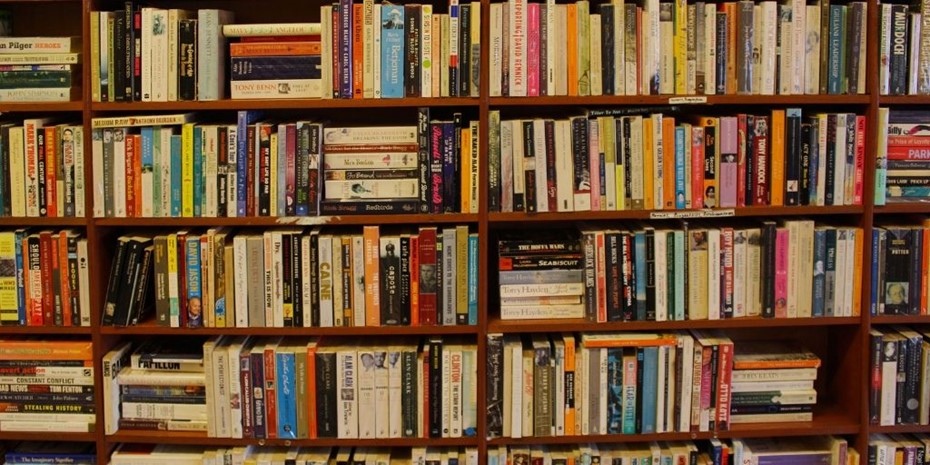



Search
Search our 7.990 News Items
CATEGORIES
We found 19 books in our category 'POSTER'
We found 3 news items
We found 19 books
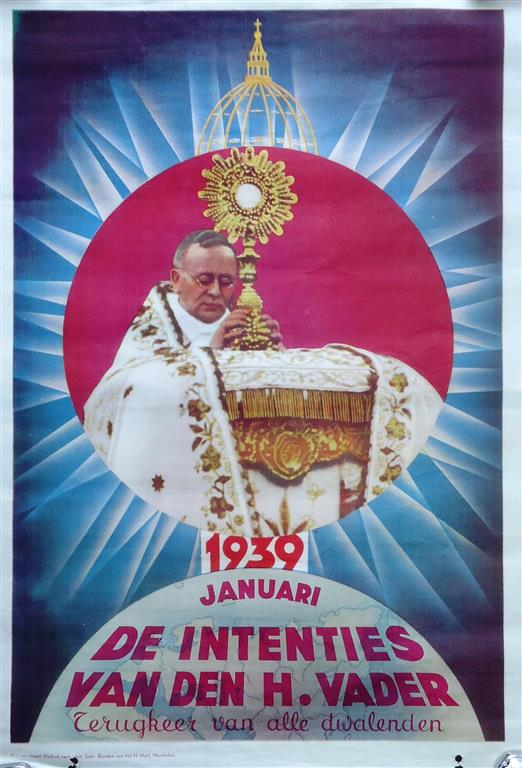
Mechelen
Algemeen Secretariaat van de Bonden van het Heilig Hart
1939
BEL 
condition:
book number: 1939000001
AFFICHE: Januari 1939: De intenties van den H. Vader: Terugkeer van alle dwalenden
Affiche in kleur, 70x46cm. Foto wordt gemaild op aanvraag
Bonden van het H. Hart@ wikipedia
€ 50.0
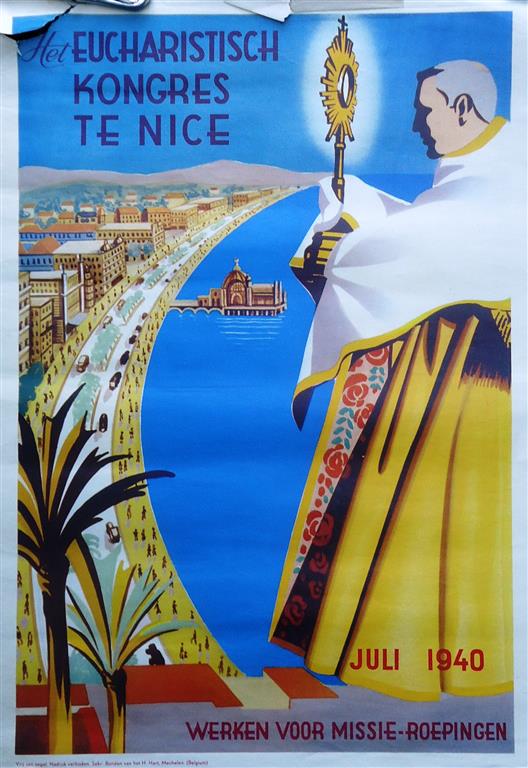
Mechelen
Algemeen Secretariaat van de Bonden van het Heilig Hart
1940
BEL 
condition:
book number: 1940000001
AFFICHE: Juli 1940: Het Eucharistisch Kongres te Nice
Affiche in kleur, 70x46cm. Foto wordt gemaild op aanvraag
Bonden van het H. Hart@ wikipedia
€ 50.0
![Book cover 1946000002: Desvaillières Georges (illustrator) | AFFICHE: November 1946: Oorlogsdooden; nood aan missieroepingen (illustratie: Glasraam van de Kapel Doodenhulde te Douaumont - Verdun) [zoekhulp: oorlogsdoden]](https://www.mers.be/COVERS_MERS/1946000002.jpg)
Mechelen
Algemeen Secretariaat van de Bonden van het Heilig Hart
1946
BEL 
condition:
book number: 1946000002
AFFICHE: November 1946: Oorlogsdooden; nood aan missieroepingen (illustratie: Glasraam van de Kapel Doodenhulde te Douaumont - Verdun) [zoekhulp: oorlogsdoden]
Affiche in kleur, 70x46cm.
Desvaillières Georges (illustrator)@ wikipedia
€ 50.0
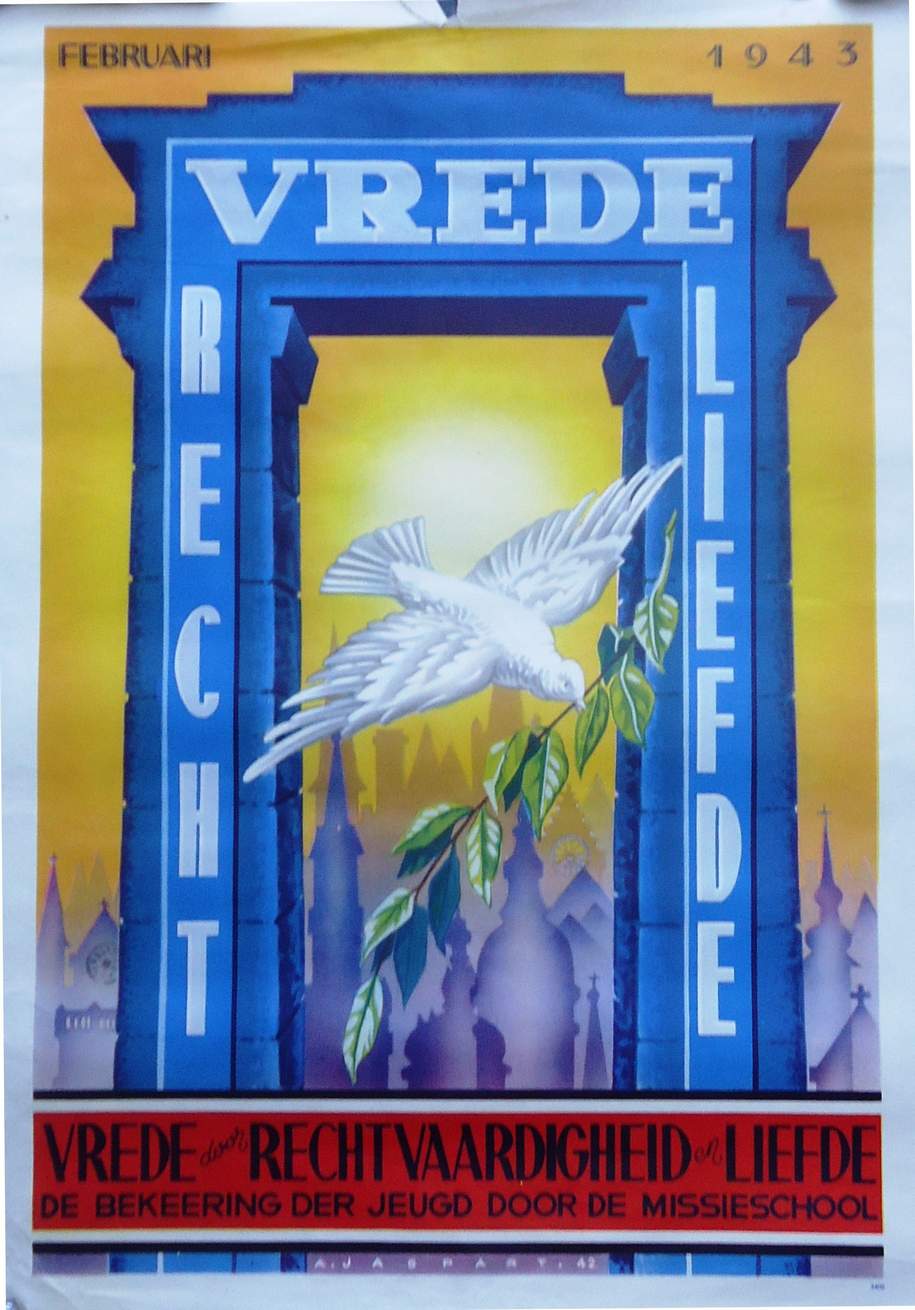
Mechelen
Algemeen Secretariaat van de Bonden van het Heilig Hart
1943
BEL 
condition:
book number: 1943000001
AFFICHE: Februari 1943: Vrede, Rechtvaardigheid, Liefde (witte duif met takje)
Affiche in kleur, 70x46cm. Foto wordt gemaild op aanvraag. Noot LT: Wilde men in 1943 in katholieke kringen tot een wapenstilstand komen?
JASPART A. (illustrator)@ wikipedia
€ 50.0
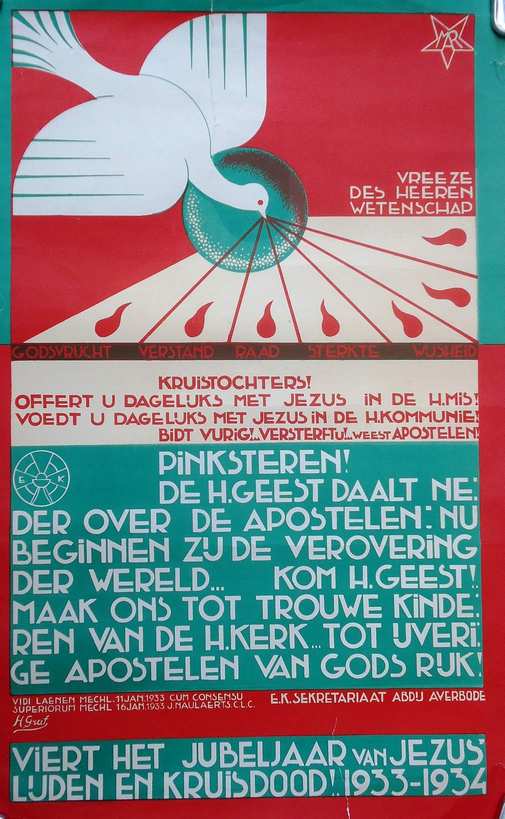
Mechelen
Algemeen Secretariaat van de Bonden van het Heilig Hart
1933
BEL 
condition:
book number: 193300001
AFFICHE: Pinksteren, etc. Viert het Jubeljaar van Jezus lijden en kruisdood! 1933-1934
Affiche in kleur, 70x46cm. Foto wordt gemaild op aanvraag
NN.@ wikipedia
€ 50.0
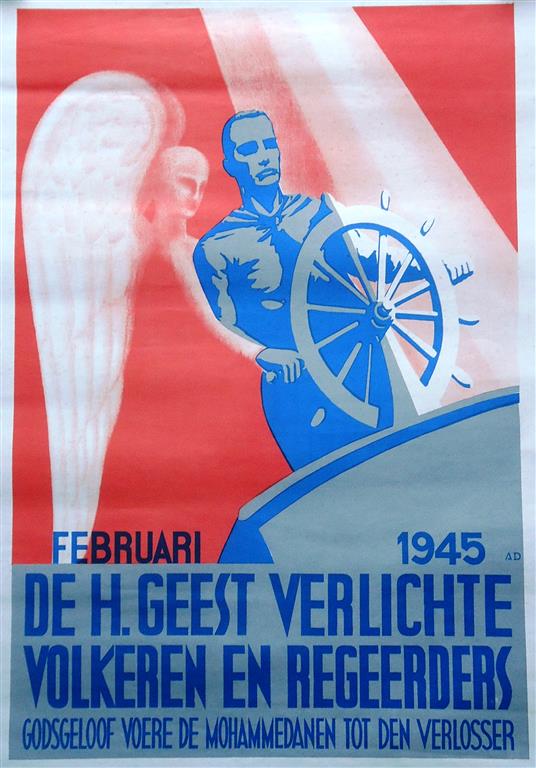
Mechelen
Algemeen Secretariaat van de Bonden van het Heilig Hart
1945
BEL 
condition:
book number: 1945000001
AFFICHE: Februari 1945: De H. Geest verlichte volkeren en regeerders; Godsgeloof voere de Mohammedanen tot den Verlosser. (illustratie: kapitein aan roer wordt geholpen door berschermengel)
Affiche in kleur, 70x46cm. Foto wordt gemaild op aanvraag
NN.@ wikipedia
€ 50.0
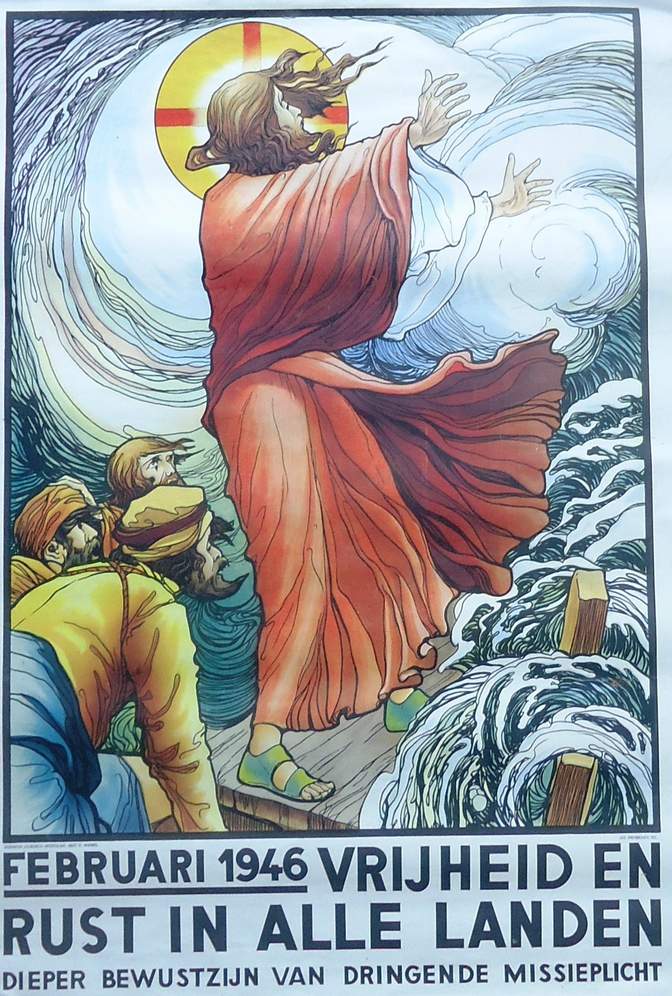
Mechelen
Algemeen Secretariaat van de Bonden van het Heilig Hart
1946
BEL 
condition:
book number: 1946000001
AFFICHE: Februari 1946: Vrijheid en rust in alle landen; Dieper bewustzijn van dringende missieplicht (illustratie: zeer mooi uitgevoerde Jezusfiguur die de storm bedaart)
Affiche in kleur, 70x46cm. Foto wordt gemaild op aanvraag
NN.@ wikipedia
€ 50.0
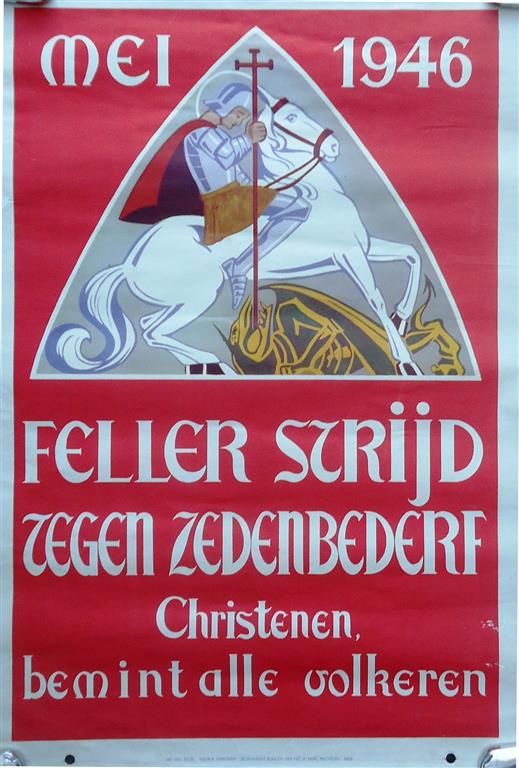
Mechelen
Algemeen Secretariaat van de Bonden van het Heilig Hart
1946
BEL 
condition:
book number: 1946000003
AFFICHE: Mei 1946: Feller strijd tegen zedenbederf; Christenen, bemint alle volkeren (Illustratie: Sint-Michiel doodt de draak)
Affiche in kleur, 70x46cm.
NN.@ wikipedia
€ 50.0
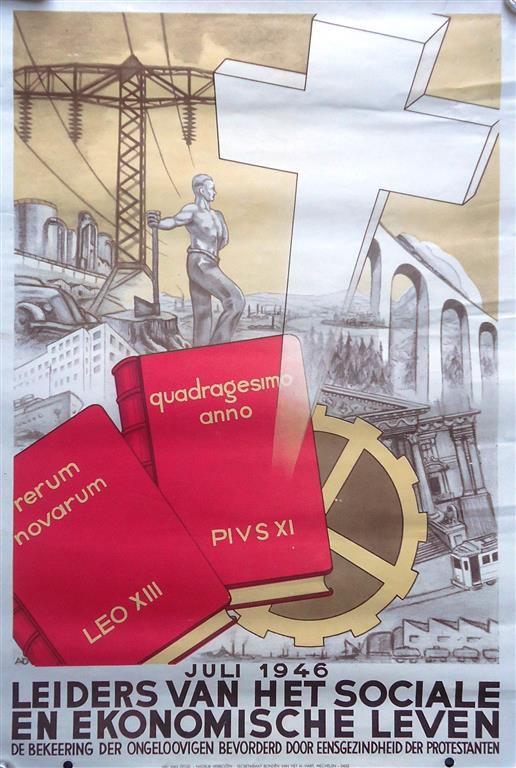
Mechelen
Algemeen Secretariaat van de Bonden van het Heilig Hart
1946
BEL 
condition:
book number: 1946000004
AFFICHE: Juli 1946: Leiders van het sociale en ekonomische leven; de bekeering der ongeloovigen bevorderd door eensgezindheid der protestanten (illustratie: de encyclieken Rerum Novarum en Quadragesimo Anno in boekvorm tegen een collage van elektriciteitsmast, rader, viadukt, industriegebouwen)
Affiche in kleur, 70x46cm.
NN.@ wikipedia
€ 50.0
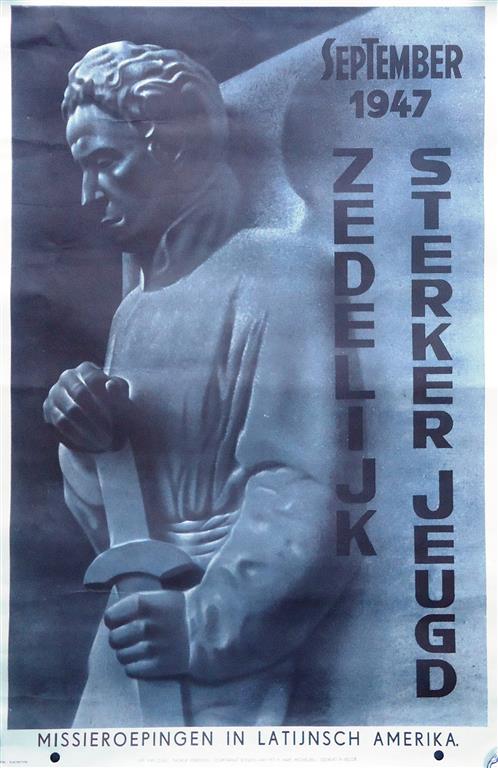
Mechelen
Algemeen Secretariaat van de Bonden van het Heilig Hart
1947
BEL 
condition:
book number: 1947000002
AFFICHE: September 1947: Zedelijk sterker jeugd (illustratie: gebeeldhouwde aartsengel Michael)
Affiche in grisaille, 70x46cm. F
NN.@ wikipedia
€ 50.0
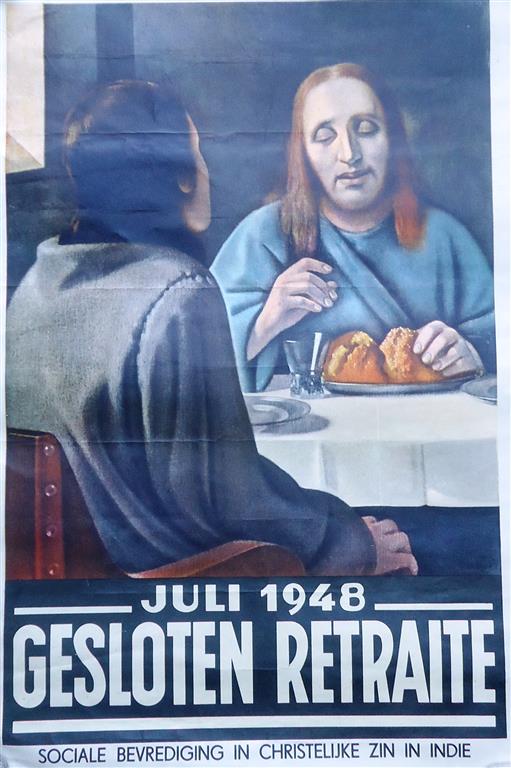
Mechelen
Algemeen Secretariaat van de Bonden van het Heilig Hart
1948
BEL 
condition:
book number: 1948000001
AFFICHE: Juli 1948: Gesloten retraite; sociale bevrediging in christelijke zin in Indië
Affiche in kleur, 70x46cm.
NN.@ wikipedia
€ 50.0
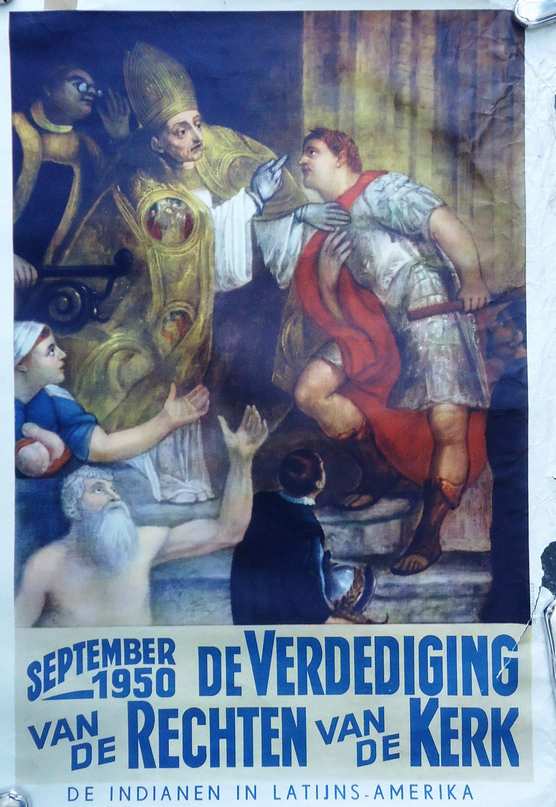
Mechelen
Algemeen Secretariaat van de Bonden van het Heilig Hart
1950
BEL 
condition: scheur van enkele cm rechts onderaan; geen verlies in de afbeelding
book number: 1950000002
AFFICHE: September 1950: De verdediging van de rechten van de Kerk (illustratie: een kardinaal met mijter vermaant en weert een Romeins veldheer uit een kerkgebouw)
Affiche in kleur, 70x46cm.
NN.@ wikipedia
€ 50.0
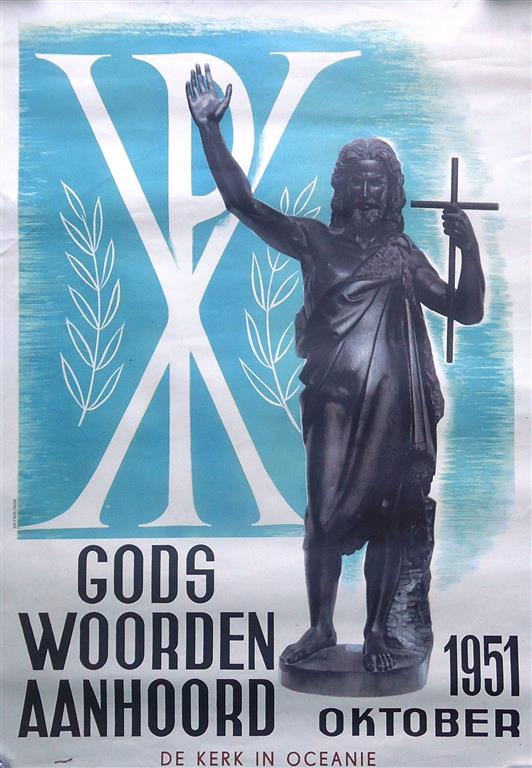
Mechelen
Algemeen Secretariaat van de Bonden van het Heilig Hart
1951
BEL 
condition:
book number: 1951000001
AFFICHE: Oktober 1951: Gods woorden aanhoord; de kerk in Oceanië
Affiche in kleur, 70x46cm.
NN.@ wikipedia
€ 50.0
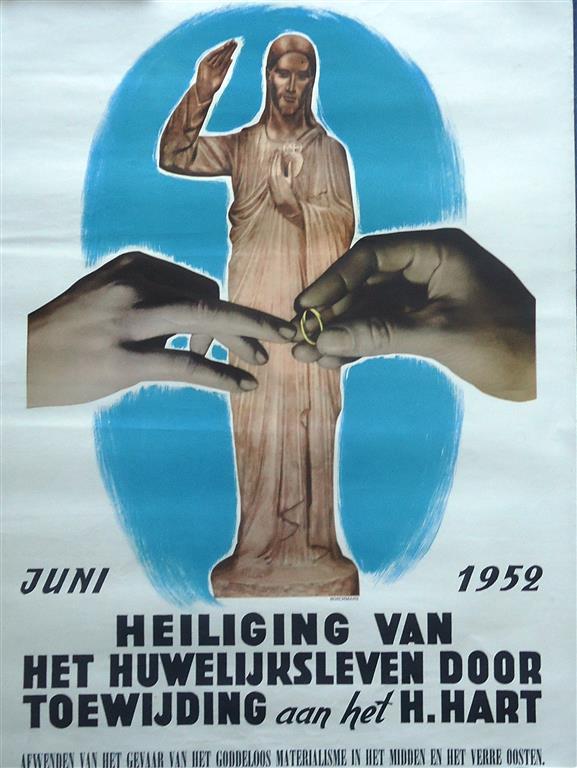
Mechelen
Algemeen Secretariaat van de Bonden van het Heilig Hart
1952
BEL 
condition:
book number: 1952000001
AFFICHE: Juni 1952: Heiliging van het huwelijksleven door toewijding aan het H. Hart (illustratie: H. Hart zegent aan de vinger geschoven trouwring); afwenden van het gevaar van het goddeloos materialisme in het Midden en Verre Oosten
Affiche in kleur, 70x46cm.
NN.@ wikipedia
€ 50.0
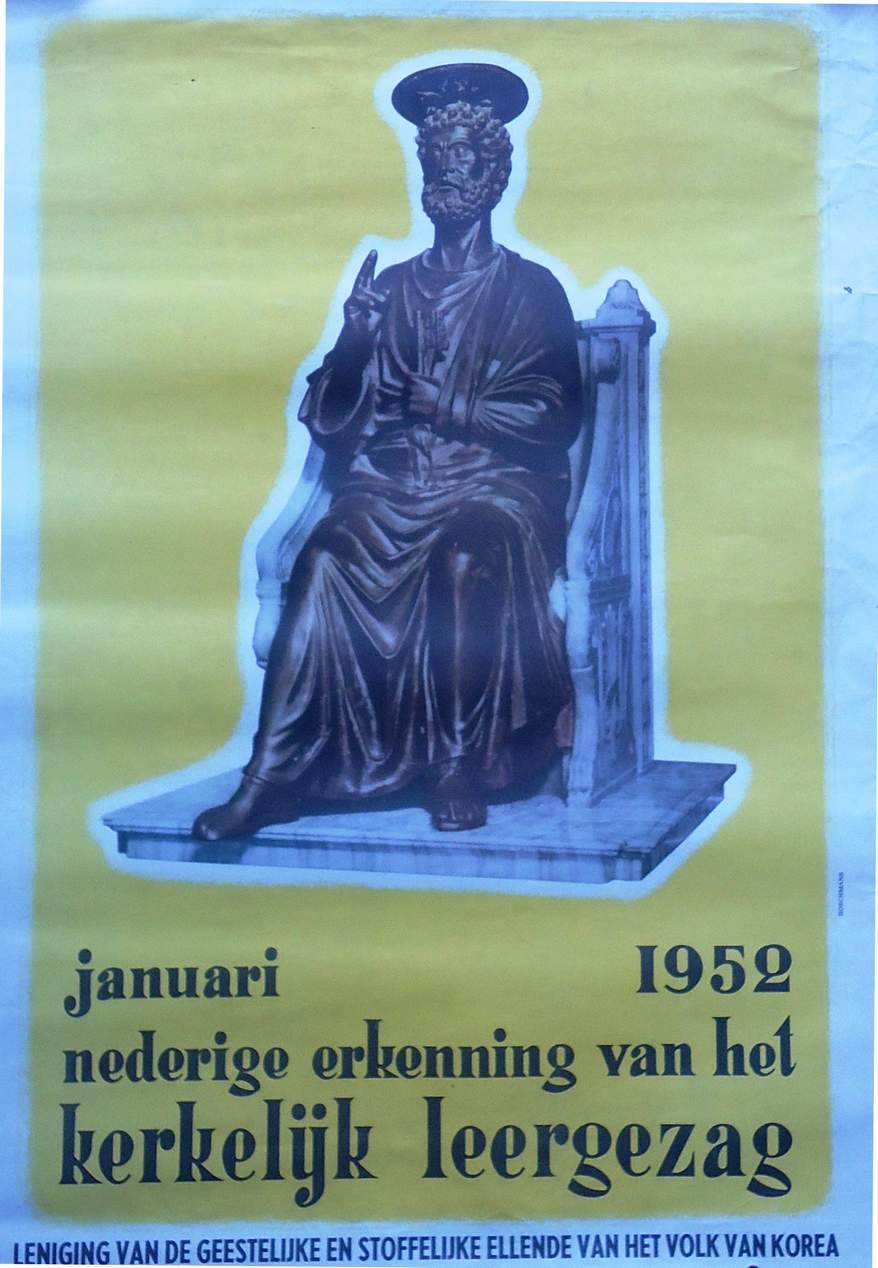
Mechelen
Algemeen Secretariaat van de Bonden van het Heilig Hart
1952
BEL 
condition:
book number: 1952000002
AFFICHE: Januari 1952: Nederige erkenning van het kerkelijk leergezag; leiding van de geestelijke en stoffelijke ellende van het volk van Korea
Affiche in kleur, 70x46cm.
NN.@ wikipedia
€ 50.0
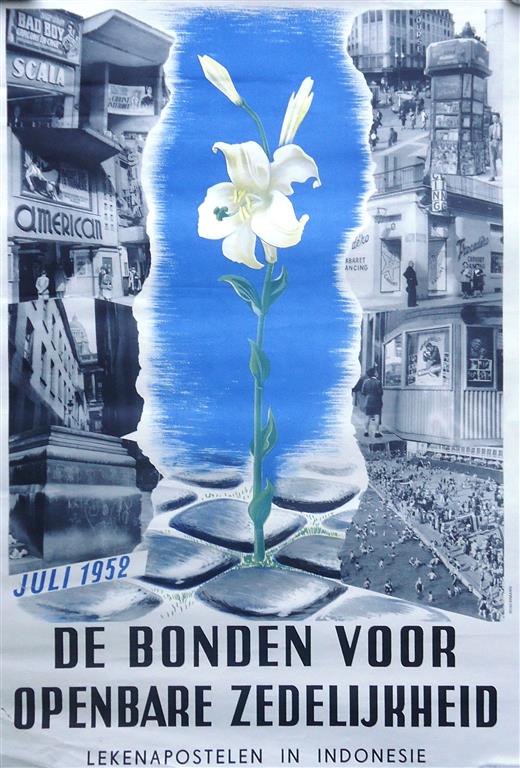
Mechelen
Algemeen Secretariaat van de Bonden van het Heilig Hart
1952
BEL 
condition:
book number: 1952000003
AFFICHE: Juli 1952: De bonden voor openbare zedelijkheid (illustratie: opbloeiende lelie temidden van collage van bioscoopgebouwen en entrees van cabaretten)
Affiche in kleur, 70x46cm.
NN.@ wikipedia
€ 50.0
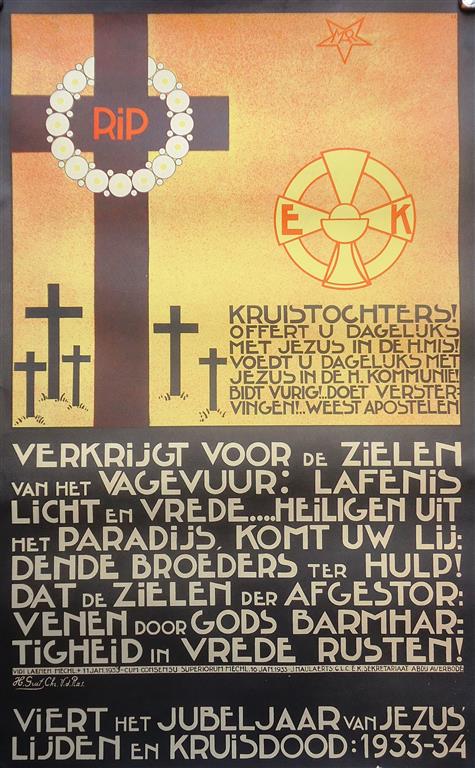
Mechelen
Algemeen Secretariaat van de Bonden van het Heilig Hart
1933
BEL 
condition:
book number: 1933000002
AFFICHE: Kruistochters! Offert u dagelijks met Jezus in de H. Mis! Etcetera. Viert het Jubeljaar van Jezus lijden en kruisdood! 1933-1934
Affiche in kleur, 70x46cm. Foto wordt gemaild op aanvraag
V. d. Plas Chr. (H. Graf)@ wikipedia
€ 50.0
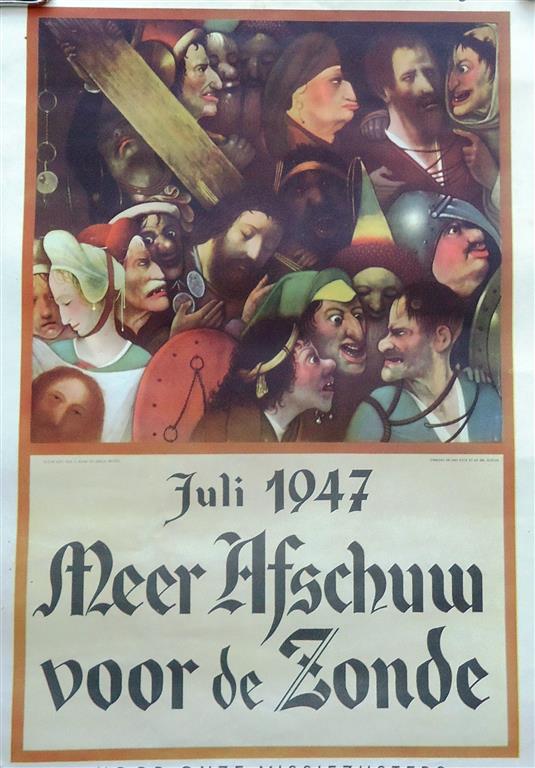
Mechelen
Algemeen Secretariaat van de Bonden van het Heilig Hart
1947
BEL 
condition:
book number: 1947000001
AFFICHE: Juli 1947: Meer afschuw voor de Zonde
Affiche in kleur, 70x46cm.
VAN EYCK en Jeroen Bosch (reproductie van detail)@ wikipedia
€ 50.0
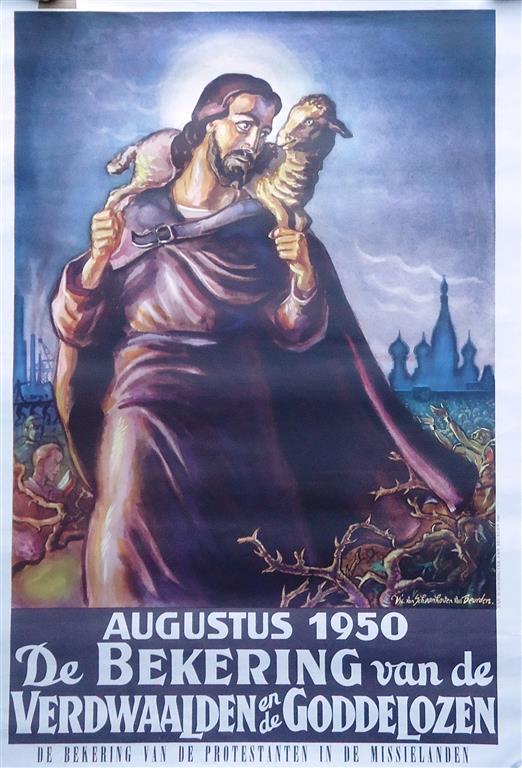
Mechelen
Algemeen Secretariaat van de Bonden van het Heilig Hart
1950
BEL 
condition:
book number: 1950000001
AFFICHE: Augustus 1950: De bekering van de verdwaalden en de goddelozen; de bekering van de protestanten in de missielanden (illustratie: Jezus redt het verloren lam uit de doornstruiken)
Affiche in kleur, 70x46cm. Foto wordt gemaild op aanvraag. De illustrator Victor R.A.J. Van Schoonhoven van Beurden (°Roermond 22/1/1900, +Breda 5/2/1977) volgde een opleiding aan de Academies van Rotterdam en Den Haag; hij was ook boekillustrator.
VAN SCHOONHOVEN VAN BEURDEN Vic. (illustrator)@ wikipedia
€ 50.0
We found 3 news items
D-Day in Kinshasa
ID: 202312201016
By Erik Kennes (20 December 2023)
Today is voting day in Kinshasa. While it is very likely that incumbent President Tshisekedi will be proclaimed the winner, the question is at what cost.
*****
On 5 December, the president of the Independent National Electoral Commission (CENI) requested important logistical assistance from the government to enable transportation of remaining election materials all over the country. The DRC government as well as the Angolan authorities agreed, but the operations became effective only on 17 December. The day before, the Security Council authorized MONUSCO to assist the CENI beyond its current area of deployment. Obviously, only a miracle can ensure a timely delivery and the organisation of elections all over DRC territory, beyond the urban centres.
Many technical problems have found unsatisfactory ad hoc solutions, seriously affecting the elections’ credibility. The voters lists were not published according to legal requirements but may be consulted at the local electoral offices. Many voters’ cards issued which were indecipherable were not replaced; the officers at the polling station will verify whether a voter has his name and picture on an (unpublished) list to decide whether the person is allowed to vote or not. Many problems the CENI was confronted with during the voters’ registration, such as defective machines and lack of trained personnel, may well occur again, due to last minute organisational challenges.
Lack of adequate communication and transparency from the CENI towards political parties and civil society is another factor affecting the credibility of the electoral process. Rumours abound about the likelihood of electoral fraud, and many are convinced that the incumbent President tries by all means – legal as well as illegal – to obtain a second presidential mandate.
Many actions from President Tshisekedi can indeed be considered as electorally motivated, such as his management of the crisis in the East (North and South Kivu and Ituri represent 19% of the registered voters), a Program for Local Development of all DRC’s 145 territories, or the appointment of allies at all election management institutions. His control of the territorial administration, the official media, and the security forces provides him an undeniable advantage. In several instances, efforts were made by officials of these institutions to block or sabotage opposition campaigns, especially targeting Moise Katumbi and Denis Mukwege. In Moanda, on 12 December, police forces even shot real bullets at a Katumbi meeting, while his party’s local youth league president was killed in Kindu on 27 November.
Tshisekedi’s campaign highlights the infrastructure he allegedly has built all over the country and brandishes the slogan “unity, security, prosperity”. The president’s program on paper is excellent and includes many innovative and interesting ideas, but the phasing of its actual implementation as well as its funding are not discussed. Critics say that the program is another chapter in the series of the President’s unrealised promises during his first mandate. This assessment may be an exaggeration, but the levels of impunity, corruption, parallel powers of the presidential family and the appointment of many natives from the President’s home area were hardly appreciated outside the presidential coalition “Sacred Union”.
The candidates’ programmes are unknown to the vast majority of the electorate and are therefore not at all part of the campaign. Instead, the Presidential coalition correctly identified the popular politician Moise Katumbi as the major electoral threat and therefore focused attention on nationality issues to discredit Katumbi’s presidential ambitions. Katumbi is the son of a Jewish father from Rhodos and a Congolese Bemba-Yeke mother. As the Bemba live across the DRC-Zambian border in both countries, and as Katumbi as a businessman has had many dealings in Zambia, he was quickly accused of being a Zambian national by members and supporters of the governing coalition. Images circulate of a “Zambian diplomatic passport” allegedly given to Katumbi on social media, but the Zambian authorities have officially denied any Zambian nationality. This seems like a replay of the Kabila presidency when Katumbi was accused of having the Italian nationality, which was denied by the Italian authorities. More problematic for the population in East-Congo is Katumbi’s spouse, who is the Tutsi daughter of a former Burundian ambassador of the Buyoya regime. This does not go down well among a substantial part of the population in Kivu with sharp anti-Tutsi attitudes. The substantially senseless propaganda on Katumbi’s nationality in combination with his wife’s ethnicity, may reduce his electoral support.
Fayulu very probably won the 2018 election because he de facto represented the electorally very strong Katumbi who was barred from participation at the time. Since then, Fayulu has played it alone and initially refused to participate in the elections, refusing to align candidates from his party for the National or Provincial Assemblies. He changed his mind to stand as a presidential candidate and appears to be convinced that he still enjoys nationwide support. Fayulu is the strongest candidate in the West and probably has important levels of support in the capital, but contrary to Katumbi, he lacks sufficient means to efficiently counter the massive electoral propaganda machine set up by the President’s coalition in Kinshasa and elsewhere, where Tshisekedi’s picture figures on almost each and every poster of candidates for the National Assembly, as well as on countless huge posters along the city’s main roads.
The other key presidential candidate is Dr. Denis Mukwege, yet his chances of electoral success are limited because he is virtually unknown in the western part of the country. As the symbol for political renewal and moral integrity, and with an uncompromising attitude towards the many aggressions by Rwanda since 1998, he enjoys the support of many civil society organizations in the East. He is still challenged on these issues by Tshisekedi who is also appreciated by many in the East for his uncompromising stance against Rwanda, despite the chaotic management of the crisis in the East by the DRC government.
In sum, everything is set for electoral chaos and for the results to be contested for lack of transparency of the entire process. For the same reasons and because of the technical and logistic challenges, many expect a high abstention rate. The activities of the electoral observation network organized by a coalition of the Catholic and Protestant churches will be crucial: in 2018 the results of their observation provided strong evidence of the electoral fraud committed. Now that the observation mission from the European Union is limited to a small team in Kinshasa, the Carter Center will be the only international organization able to credibly assess the official election results.
Unfortunately, the electoral process and the candidate selection for the national and provincial assembly went on almost unnoticed. With more than 25 000 candidates for 484 seats in the National Assembly and more than 44 000 for the 764 provincial assembly seats, the results will be massively contested before the constitutional court which has two months to examine the cases. If no decision is taken by the Court on a case, e.g. because of time constraints, the provisional result published by the electoral commission is considered final (art. 74 of the electoral law). Suspicion of electoral fraud such as that committed in 2018 can easily trigger violence.
Another often underestimated cause of violence is ethnic representation. Once a president comes to power, his ethnic group considers itself to be entitled to authority and power, to appointments at official functions. If the results of the National and Provincial elections were to display a disproportional presence of natives from the Kasai regions (Tshisekedi ethnic area) compared to their presence in their respective constituencies, this may easily trigger violent conflict. This is most important in the four ex-Katanga provinces where relations between natives from Katanga and Kasai have historically been conflictual. As the country is economically heavily dependent on the mines of Katanga, and the presidential family is very active in mining matters, a disproportional representation of Katanga by natives from Kasai will be interpreted as an effort by the latter to dominate the Katangese, in an already very tense situation.
Some analysts speculate on the possibility of a coup d’état during or after a chaotic election. The military strongman under the Kabila Presidency, John Numbi, called several times for a coup on social media and the former CENI president Corneille Nangaa, who orchestrated the 2018 electoral fraud, announced on 15 December the creation of a highly disturbing political platform of several rebel movements and armed groups in the East, including the M23. Although predictions are hard to make, a coup is not a guarantee for stability and may possibly lead to more violence. What seems sure already is that the 2023 elections will go down as the worst organized and the most contested of the entire electoral cycle started in 2006.
Today is voting day in Kinshasa. While it is very likely that incumbent President Tshisekedi will be proclaimed the winner, the question is at what cost.
*****
On 5 December, the president of the Independent National Electoral Commission (CENI) requested important logistical assistance from the government to enable transportation of remaining election materials all over the country. The DRC government as well as the Angolan authorities agreed, but the operations became effective only on 17 December. The day before, the Security Council authorized MONUSCO to assist the CENI beyond its current area of deployment. Obviously, only a miracle can ensure a timely delivery and the organisation of elections all over DRC territory, beyond the urban centres.
Many technical problems have found unsatisfactory ad hoc solutions, seriously affecting the elections’ credibility. The voters lists were not published according to legal requirements but may be consulted at the local electoral offices. Many voters’ cards issued which were indecipherable were not replaced; the officers at the polling station will verify whether a voter has his name and picture on an (unpublished) list to decide whether the person is allowed to vote or not. Many problems the CENI was confronted with during the voters’ registration, such as defective machines and lack of trained personnel, may well occur again, due to last minute organisational challenges.
Lack of adequate communication and transparency from the CENI towards political parties and civil society is another factor affecting the credibility of the electoral process. Rumours abound about the likelihood of electoral fraud, and many are convinced that the incumbent President tries by all means – legal as well as illegal – to obtain a second presidential mandate.
Many actions from President Tshisekedi can indeed be considered as electorally motivated, such as his management of the crisis in the East (North and South Kivu and Ituri represent 19% of the registered voters), a Program for Local Development of all DRC’s 145 territories, or the appointment of allies at all election management institutions. His control of the territorial administration, the official media, and the security forces provides him an undeniable advantage. In several instances, efforts were made by officials of these institutions to block or sabotage opposition campaigns, especially targeting Moise Katumbi and Denis Mukwege. In Moanda, on 12 December, police forces even shot real bullets at a Katumbi meeting, while his party’s local youth league president was killed in Kindu on 27 November.
Tshisekedi’s campaign highlights the infrastructure he allegedly has built all over the country and brandishes the slogan “unity, security, prosperity”. The president’s program on paper is excellent and includes many innovative and interesting ideas, but the phasing of its actual implementation as well as its funding are not discussed. Critics say that the program is another chapter in the series of the President’s unrealised promises during his first mandate. This assessment may be an exaggeration, but the levels of impunity, corruption, parallel powers of the presidential family and the appointment of many natives from the President’s home area were hardly appreciated outside the presidential coalition “Sacred Union”.
The candidates’ programmes are unknown to the vast majority of the electorate and are therefore not at all part of the campaign. Instead, the Presidential coalition correctly identified the popular politician Moise Katumbi as the major electoral threat and therefore focused attention on nationality issues to discredit Katumbi’s presidential ambitions. Katumbi is the son of a Jewish father from Rhodos and a Congolese Bemba-Yeke mother. As the Bemba live across the DRC-Zambian border in both countries, and as Katumbi as a businessman has had many dealings in Zambia, he was quickly accused of being a Zambian national by members and supporters of the governing coalition. Images circulate of a “Zambian diplomatic passport” allegedly given to Katumbi on social media, but the Zambian authorities have officially denied any Zambian nationality. This seems like a replay of the Kabila presidency when Katumbi was accused of having the Italian nationality, which was denied by the Italian authorities. More problematic for the population in East-Congo is Katumbi’s spouse, who is the Tutsi daughter of a former Burundian ambassador of the Buyoya regime. This does not go down well among a substantial part of the population in Kivu with sharp anti-Tutsi attitudes. The substantially senseless propaganda on Katumbi’s nationality in combination with his wife’s ethnicity, may reduce his electoral support.
Fayulu very probably won the 2018 election because he de facto represented the electorally very strong Katumbi who was barred from participation at the time. Since then, Fayulu has played it alone and initially refused to participate in the elections, refusing to align candidates from his party for the National or Provincial Assemblies. He changed his mind to stand as a presidential candidate and appears to be convinced that he still enjoys nationwide support. Fayulu is the strongest candidate in the West and probably has important levels of support in the capital, but contrary to Katumbi, he lacks sufficient means to efficiently counter the massive electoral propaganda machine set up by the President’s coalition in Kinshasa and elsewhere, where Tshisekedi’s picture figures on almost each and every poster of candidates for the National Assembly, as well as on countless huge posters along the city’s main roads.
The other key presidential candidate is Dr. Denis Mukwege, yet his chances of electoral success are limited because he is virtually unknown in the western part of the country. As the symbol for political renewal and moral integrity, and with an uncompromising attitude towards the many aggressions by Rwanda since 1998, he enjoys the support of many civil society organizations in the East. He is still challenged on these issues by Tshisekedi who is also appreciated by many in the East for his uncompromising stance against Rwanda, despite the chaotic management of the crisis in the East by the DRC government.
In sum, everything is set for electoral chaos and for the results to be contested for lack of transparency of the entire process. For the same reasons and because of the technical and logistic challenges, many expect a high abstention rate. The activities of the electoral observation network organized by a coalition of the Catholic and Protestant churches will be crucial: in 2018 the results of their observation provided strong evidence of the electoral fraud committed. Now that the observation mission from the European Union is limited to a small team in Kinshasa, the Carter Center will be the only international organization able to credibly assess the official election results.
Unfortunately, the electoral process and the candidate selection for the national and provincial assembly went on almost unnoticed. With more than 25 000 candidates for 484 seats in the National Assembly and more than 44 000 for the 764 provincial assembly seats, the results will be massively contested before the constitutional court which has two months to examine the cases. If no decision is taken by the Court on a case, e.g. because of time constraints, the provisional result published by the electoral commission is considered final (art. 74 of the electoral law). Suspicion of electoral fraud such as that committed in 2018 can easily trigger violence.
Another often underestimated cause of violence is ethnic representation. Once a president comes to power, his ethnic group considers itself to be entitled to authority and power, to appointments at official functions. If the results of the National and Provincial elections were to display a disproportional presence of natives from the Kasai regions (Tshisekedi ethnic area) compared to their presence in their respective constituencies, this may easily trigger violent conflict. This is most important in the four ex-Katanga provinces where relations between natives from Katanga and Kasai have historically been conflictual. As the country is economically heavily dependent on the mines of Katanga, and the presidential family is very active in mining matters, a disproportional representation of Katanga by natives from Kasai will be interpreted as an effort by the latter to dominate the Katangese, in an already very tense situation.
Some analysts speculate on the possibility of a coup d’état during or after a chaotic election. The military strongman under the Kabila Presidency, John Numbi, called several times for a coup on social media and the former CENI president Corneille Nangaa, who orchestrated the 2018 electoral fraud, announced on 15 December the creation of a highly disturbing political platform of several rebel movements and armed groups in the East, including the M23. Although predictions are hard to make, a coup is not a guarantee for stability and may possibly lead to more violence. What seems sure already is that the 2023 elections will go down as the worst organized and the most contested of the entire electoral cycle started in 2006.
Land: COD

Wie is eigenaar van de Franse media? (print, TV, radio)
ID: 201612051261
 Een poster van Le Monde Diplomatique brengt de eigendomsstructuren in beeld.
Een poster van Le Monde Diplomatique brengt de eigendomsstructuren in beeld.klik hier
site van Acrimed voor groter beeld
Land: FRA

Wie is eigenaar van de Franse media?
ID: 201612051261
Land: FRA

